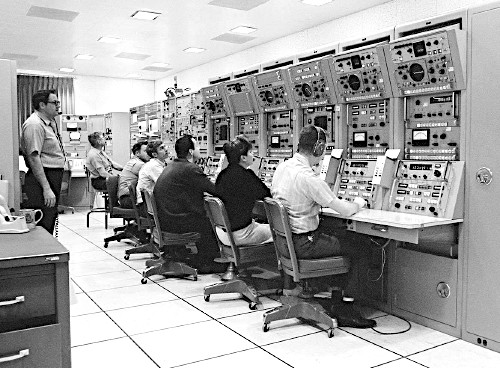


Goldstone Apollo 11 Scan-converted TV
 |
 |
 |
Shortly after the conclusion of the Apollo 11 Moonwalk, Goldstone lead USB engineer
Bill Wood replayed the videotape of the scan-converted television and
took a sequence of around 80 photographs with his 35mm film still camera.
He did not regard his set of photos as being particularly unique, since a Public Affairs official had been taking Polaroid photos of the much better slow scan TV in a specially equipped trailer (one known surviving example here). In addition, it was assumed that the slow scan telemetry tapes would be preserved.
During his participation in the search for the Apollo 11 slow scan TV tapes, Bill printed the negatives for the first time in late 2006.
Bill writes –
“I took the photos after the Moon set at Goldstone late in the evening on 20 July local California time (21 July UTC).
My USB crew had the 6 PM to 6 AM shift at Goldstone. I set up my Nikon F camera on a tripod in front of the RCA Scan Converter 14-inch HP TV monitor and played back the Ampex VR-660 recording of the scan converter output while snapping away with the camera.”
These photos demonstrate the problems the Goldstone scan converter operator had at the start of the Moonwalk TV. While the slow-scan TV being received from the Moon was of high quality, the scan-converter (which converted the 320 line, 10 frames per second, picture to a 525 line, 30 frames per second picture) was producing a very dark NTSC output. This can be seen in the first of Bill’s photos.
Not long after, the scan-converter settings were improved, and the picture was much brighter however, by this stage, Houston TV was sending the pictures from Honeysuckle Creek, and then Parkes, out to the worldwide TV broadcast.
Even with the improved settings, the Goldstone scan-converter did not perform as well as those at Honeysuckle Creek and Sydney (which processed the Parkes picture). Nevertheless, Bill’s sequence of photos is a unique record of mankind’s first excursion on the Moon – and is the most extensive set of photos of the scan-converted TV taken at the tracking stations.
 |
 |
| Apollo Goldstone Lead-USB Engineer Bill Wood (standing at left) – photo taken during the Apollo 10 mission. | A more recent photo. |